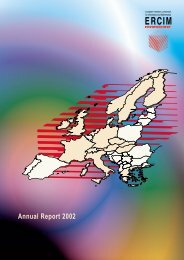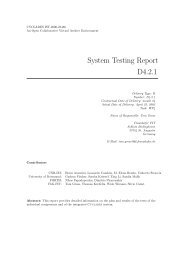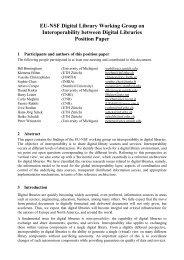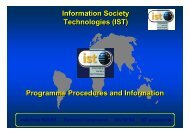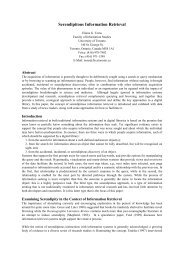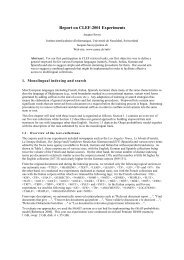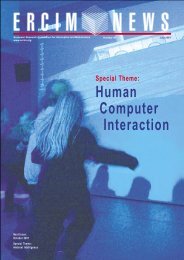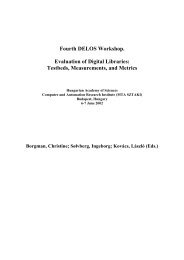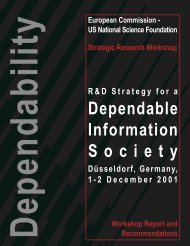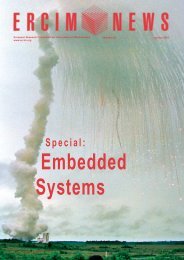Towards a Platform for Widespread Embedded Intelligence - ERCIM
Towards a Platform for Widespread Embedded Intelligence - ERCIM
Towards a Platform for Widespread Embedded Intelligence - ERCIM
Create successful ePaper yourself
Turn your PDF publications into a flip-book with our unique Google optimized e-Paper software.
iments. We tested and evaluated several<br />
development boards <strong>for</strong> different<br />
FPGAs. However, the flexibility of<br />
reconfiguration was a limitation on most<br />
of them. In the end we chose a very<br />
simple and available FPGA board, the<br />
so-called 'Suzaku system', which was<br />
small and allowed us the flexibility of<br />
reconfiguration that we required. This<br />
system is really a Single Board<br />
Computer in an FPGA with an external<br />
flash memory <strong>for</strong> reconfiguration data<br />
and some communication controllers <strong>for</strong><br />
LAN and serial line I/O.<br />
We are now at version 1.0 of our project<br />
roadmap. This is the first major version<br />
where the tags are independent of any<br />
development PCs or external computers.<br />
The tag is now completely embedded on<br />
the Suzaku board where the Xilinx<br />
Spartan FPGA is configured with a<br />
Microblaze CPU and devices <strong>for</strong> running<br />
a Linux operating system variant.<br />
Additionally, the tags are independent in<br />
the sense that they can reconfigure themselves.<br />
A simple web server is running<br />
on the tag and, through a specific interface,<br />
clients may download new configurations<br />
<strong>for</strong> the FPGA, then the tag will<br />
reconfigure itself and come alive again<br />
with the basic CPU + Linux configuration<br />
plus the newly configured hardware<br />
architecture and the interconnections<br />
between these sub-systems. The web<br />
server interface enables a client to down-<br />
Media streaming execution.<br />
System-Level Design<br />
of Fault-Tolerant <strong>Embedded</strong> Systems<br />
by Alain Girault<br />
load new configurations either directly<br />
from itself or from any networked server<br />
holding properly defined system configurations.<br />
In order to test version 1.0 of the<br />
AHEAD tag, we are currently developing<br />
a demonstrator <strong>for</strong> MPEG recoding<br />
and re-scaling. The objective is to<br />
configure the tag <strong>for</strong> receiving massively<br />
encoded media streams such as the<br />
MPEG4 <strong>for</strong>mat and to decode the<br />
stream, downscale it <strong>for</strong> a small screen<br />
low-resolution viewer such as a PDA or<br />
a Smartphone and recode the stream in a<br />
more easily decoded MPEG <strong>for</strong>mat (see<br />
illustration). MPEG4-streams are of<br />
course well suited to limited bandwidth<br />
Fault-tolerance is the ability of a system to maintain its functionality, even in the<br />
presence of faults. With the advent of ubiquitous computing and distributed<br />
embedded systems, it is becoming an aspect more and more crucial. We have<br />
provided new functionalities to the SynDEx system-level CAD software. SynDEx<br />
is ideal <strong>for</strong> optimising distributed real-time embedded systems and our new<br />
functionalities allow us to guarantee a specified fault-tolerance level <strong>for</strong> the<br />
generated embeddable code.<br />
Our contribution to research in the faulttolerant<br />
embedded systems consists of<br />
several scheduling/distribution heuristics.<br />
Their common feature is to take as<br />
an input two graphs: a data-flow graph<br />
ALG describing the algorithm of the<br />
application and a graph ARC describing<br />
the target distributed architecture (see<br />
figure).<br />
SPECIAL THEME: <strong>Embedded</strong> <strong>Intelligence</strong><br />
distribution over the net, but the complexity<br />
of decoding them is too<br />
demanding <strong>for</strong> low per<strong>for</strong>mance and<br />
limited power devices such as PDAs and<br />
Smartphones. The tag recodes the stream<br />
<strong>for</strong> less per<strong>for</strong>mance and power in<br />
decoding, but the <strong>for</strong>mat will demand a<br />
higher bandwidth. This demand, however,<br />
is not a problem since the tag and<br />
the client are very close and higher bandwidths<br />
are possible even with low<br />
power. We expect to test this tag-based<br />
recoder version of AHEAD by the end of<br />
this year.<br />
Please contact:<br />
Kjetil Svarstad, NTNU, Norway<br />
E-mail: kjetil.svarstad@iet.ntnu.no<br />
Also shown is a table giving the worstcase<br />
execution time of each operation<br />
onto each processor and the worst-case<br />
transmission time of each data-dependence<br />
onto each communication link.<br />
The architecture being a priori heterogeneous,<br />
these need not be identical. Below<br />
is an example of such a table <strong>for</strong> the<br />
operations of ALG. The infinity sign<br />
expresses the fact that the operation I<br />
cannot be executed by the processor P3,<br />
<strong>for</strong> instance, to account <strong>for</strong> the requirement<br />
of certain dedicated hardware.<br />
<strong>ERCIM</strong> News No. 67, October 2006 25



